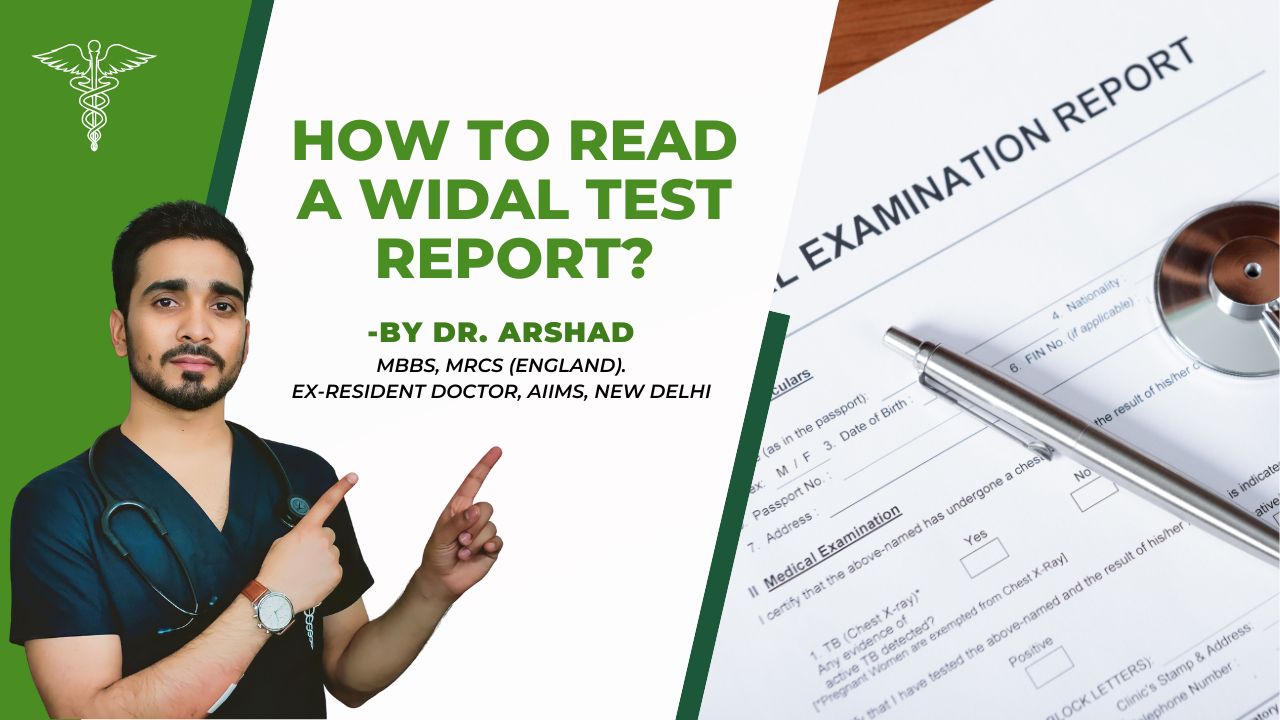The Widal test is a standard blood test to diagnose bacterial infections such as typhoid and paratyphoid fever. When you receive the report for your Widal test, it can be confusing and difficult to understand what the numbers and results mean. That’s why we have created this comprehensive guide to help you learn how to read a Widal test report. It will give you complete understanding of report interpretation, different antibody levels, and what it means by positive or negative reports.
So, don’t let a Widal test report confuse you any longer – read this guide to thoroughly understand your results and what they mean for your health.
- What Does The Widal Test Detect?
- When is Widal Test Done?
- Which Antibodies are Detected by Widal Test and What do they Indicate?
- What is Antibody Titer, and What Does it Indicate?
- Steps to Read Widal Test Reports
- Normal Widal Test Range
- Negative Widal Test
- Positive Widal Test
- What to do if your Widal test results are Negative or Positive?
- Final Words

What Does The Widal Test Detect?
Widal tests detect the presence of antibodies in the blood that are specific to certain bacterial infections. Specifically, it is used to diagnose infections caused by Salmonella typhi and Salmonella paratyphi. Salmonella typhi bacteria causes typhoid fever, and Salmonella paratyphi causes paratyphoid fever.
When is Widal Test Done?
The Widal test is usually performed if you have symptoms such as fever, headache, stomach pain, and weakness, which may indicate typhoid fever.
The Widal test may not be positive in the early stages of typhoid fever. So, the test is typically performed in the second week of illness once the body has had time to produce antibodies against the bacteria.
In cases with a strong suspicion of typhoid fever, a doctor may order the Widal test even if the symptoms have only been present for a few days.
Which Antibodies are Detected by Widal Test and What do they Indicate?
The Widal test detects the following four types of antibodies;
- O antigen: A high level of O antigen antibodies indicates that the infection is in its early stages.
- H antigen: A high level of H antigen antibodies indicates that the infection is more advanced.
- AH antigen: This antibody combines O and H antigens, indicating a recent infection.
- BH antigen: This antibody is also a combination of O and H antigens, but it indicates a past infection or a previous exposure to the bacteria.
What is Antibody Titer, and What Does it Indicate?
Antibody titer measures the concentration of antibodies in your blood against a specific pathogen such as Salmonella typhi for typhoid fever. In simpler terms, the ratio of the Ab titer tells us how much of the antibodies against these bacteria are present in your blood.
A high ratio suggests that your body has produced many antibodies against these bacteria, indicating a recent or current infection. However, a low ratio may mean you have been previously exposed to these bacteria.
Steps to Read Widal Test Reports
Here are some quick and easy steps you need to follow to read Widal test reports;
- Look for the antibodies tested in the report (O, H, AH, BH antigen).
- Check for the titer of each antibody.
- Determine whether the titers are above or below the cut-off values.
- If the values are equal to or below the cut-off values, the results are negative.
- If the titer values are above the cut-off values, the results are positive.
Normal Widal Test Range
The result corresponds to the Widal test normal value if the titer value is less than or equal to 1:20, 1:40, and 1:80 in the test report. A normal Widal test result suggests the absence of current or recent infection with typhoid fever.
Negative Widal Test
A negative Widal test means no antibodies are detected against typhoid or paratyphoid fever in your blood. It indicates that you are not exposed to any bacteria (Salmonella typhi or Salmonella paratyphi).
Widal test results are negative if the reports indicate antibody titer less than or equal to 1:20 and 1:40 and less than 1:80 (Ab titer equal to or higher than 1:80 indicates positive results).
Widal test 1:40 means negative Widal test results. A titer of 1:40 suggests a relatively lower antibody concentration against Salmonella typhi than higher titers like 1:80 or 1:160. However, it may still indicate a possible past or recent infection with typhoid fever.
Positive Widal Test
A positive Widal test means antibodies against typhoid or paratyphoid fever are in your blood. It indicates a recent or current infection. The results are reported as titer value which indicates the presence of antibodies against Salmonella typhi or Salmonella paratyphi in your blood.
The Widal test results are positive if the reports indicate a titer of O and H antigens higher than or equal to 1:60 to 1:320 or above.
Widal test 1:80 means it is a positive Widal test result that indicates the presence of antibodies against the Salmonella typhi H antigen in a person’s blood sample. The “1:80” value refers to the titer level of the antibodies detected, which measures their concentration. A titer of 1:80 suggests a relatively high concentration of antibodies against Salmonella typhi, which may indicate a recent or current infection with typhoid fever.

What to do if your Widal test results are Negative or Positive?
On having positive Widal test reports, you might be curious about widal test 1:160 treatment.
The treatment for Salmonella typhi infection with a Widal test report showing an O antigen titer of 1:160 typically involves antibiotics prescribed by a medical professional based on the severity of the infection and the patient’s medical history. Usually ciprofloxacin 500 mg is the drug of choice for Typhoid. It is given twice a day for two weeks. But you must talk to your doctor before start taking it. If you are going to travel to any high risk area, you must take Typhoid vaccine.
The positive Widal test results mean that you are infected with the bacteria being tested for. You should visit a doctor to confirm the diagnosis and treatment in this situation.
The negative Widal test results mean that you are not exposed or infected with the pathogen being tested. But, if you have symptoms of any illness, you should see a doctor for further evaluation.
Final Words
In conclusion, the Widal test is a simple blood test that helps to diagnose typhoid fever. It is a potentially life-threatening infection caused by Salmonella typhi bacteria. Understanding how to read the Widal test report is crucial to interpret the test results and diagnosing accurately and properly.
A positive Widal test result indicates the presence of antibodies against Salmonella typhi, which may indicate a current or recent infection, while a negative result suggests the absence of infection. By following the steps indicated in this extensive guide, one can interpret the Widal test report correctly and understand the significance of the test results for their health.
Have a Doubts? Book Online Consultancy.
If You are having any doubt then you can book a free online consultancy directly with me, and I will surely guide you. I am Dr. Arshad – MBBS, MRCS ( England ). Just let me know and I will do everything possible to solve your doubts or will guide you.




